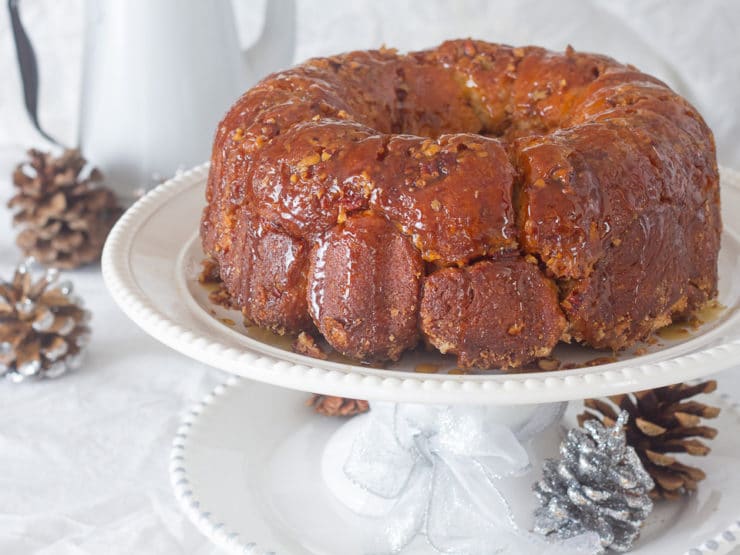
The term monkey bread, initially referring to a loaf formed from pieces of yeast dough dipped into butter, seems to have emerged or was at least popularized in southern California in the 1940s. It was a rich savory bread, sometimes accompanied with jam or preserves, requiring no knives to serve. The dough pieces were definitely not rolled in any sugary substance. Then by the early 1970s, loaves of dough pieces enveloped in either cinnamon-sugar or brown sugar — previously called Hungarian coffee cake and golden dumpling coffee cake — also became known as monkey bread, transforming the term into a beloved dessert and breakfast treat.
Throughout most of history, breads were baked freeform on the floor or wall of an oven. The requisite of baking pans (initially large wooden rings) only became necessary relatively recently with the advent of breads made from loose butter-rich dough or for a uniform rectangular shape for sandwiches. Consequently, the concept of rolling small pieces of bread dough in butter and baking them close together in a single container goes back in America only to the 19th century with the proliferation of baking pans. Some suggest this technique might have originated with those cooking in a Dutch oven, a covered pot with feet set over a fire with hot coals underneath and on top. Early variations include the Parker House roll created at Boston’s Parker House Hotel and “Finger Rolls” which appear in Mrs. Lincoln’s Boston Cook Book by Mary Johnson Lincoln (Boston, 1884). Common names for pieces of dough baked together in a pan include bubble bread, bubble loaf, jumble bread, pull-apart bread, pinch-me cake, pluck-it cake, monkey puzzle bread, monkey brains, and monkey bread.
Despite the name, there are no primates in this bread. According to conventional lore, the fanciful term comes from its appearance -– pieces of dough placed next to and on top of each other, the baked bread said to resemble a barrel of monkeys. Some suggest that the name originated when someone combined a 1940s Southern slang for snack food, “monkey food,” with a traditional jumble bread. However, it may have been silent and sound movie actress ZaSu Pitts who provided (or at the least popularized) this whimsical name. The term and recipe initially appeared in the Thursday February 8, 1945 edition of the Winnipeg Free Press (Canada) in the column Culinary Clinic (p. 11) under the title “ZaSu Pitts Just Loves to Cook,” an interview with the actress promoting her traveling play Ramshackle Inn. Besides acting, Pitts’ other primary passion was cooking and she was famous for hosting celebrities in her Brentwood home with its round kitchen and brick oven. She even posthumously published a 93-page cookbook, Candy Hits by ZaSu Pitts (New York, 1963). After discussing Ms Pitts love for cooking and sharing recipes, the article concluded:
“The next is a recipe for attractive little rolls that are baked snuggled together in a pan. These are just the things for a buffet for they’re attractive on a chop plate, and as they are buttered before baking, no further buttering is necessary.”
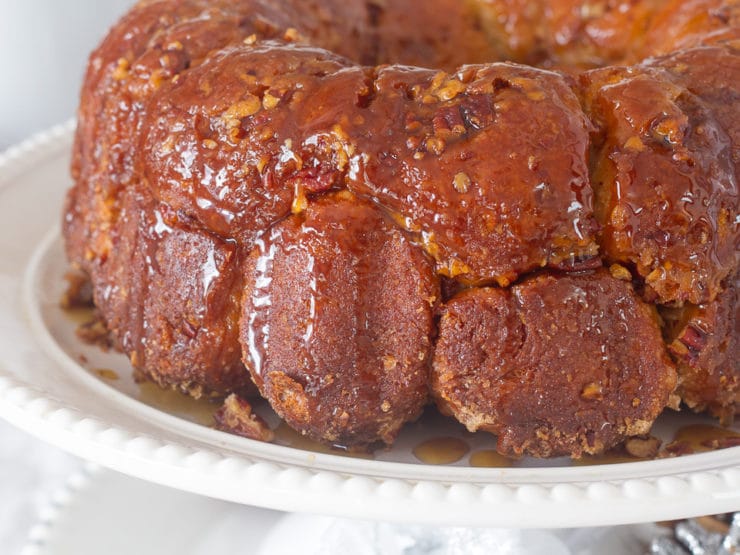
Pitts’ monkey bread was similar to Parker House rolls and Lincoln’s “Finger Rolls,” although baked in a ring pan rather than a shallow container. The central tube of the ring mold, similar to traditional dense butter-laden Alsatian-German kugelhopfs and Polish babkas, helps prevent the center from being undercooked and (due to all the butter) sinking. At this stage, monkey bread contained very little sugar and certainly no cinnamon.
Around this time, monkey bread and bubble bread began showing up in American inns and women’s magazines in other parts of the country. At this point, monkey breads were still savory, the dough containing plenty of butter, only a small amount of sugar, and frequently no eggs for an even fluffier texture. Most of the early recipes called for rolling out the dough and cutting it into diamond shapes or forming into a log and slicing. The widespread popularization of monkey bread corresponded to the advent of commercial refrigerated biscuit dough in the 1950s, which, when the two came together, rendered monkey bread somewhat commonplace in American households. Monkey bread was then rarely found in commercial bakeries, except a few in California, but became predominantly a cozy homemade treat.
Nancy and Ronald Reagan, soon after obtaining their California ranch in 1974, purchased monkey breads from a nearby bakery for each Christmas and special occasions. (I don’t know of a culinary connection, but Nancy Davis Reagan’s first professional acting job was arranged by ZaSu Pitts in that very same 1945 road tour of Ramshackle Inn.) After her husband was inaugurated president in 1981, Nancy obtained the recipe from the bakery and monkey bread became traditional Christmas fare in the White House during the Reagan administration. Nancy arranged for a monkey bread for her husband on the night before his 1987 appearance before the Iran-Contra Congressional committee. The former president purportedly remarked: “Mommy, I may go to prison, but I’ll always remember this monkey bread.” Thanks to the publicity surrounding the Reagan’s Christmas treat, it found a surge of new popularity in the 1980s, the Reagan recipe included in The White House Family Cookbook by Henry Haller (New York, 1987, p 332-333). This rendering contained three eggs and twice as much butter as the earlier versions, but still only a small amount of sugar and definitely no cinnamon.
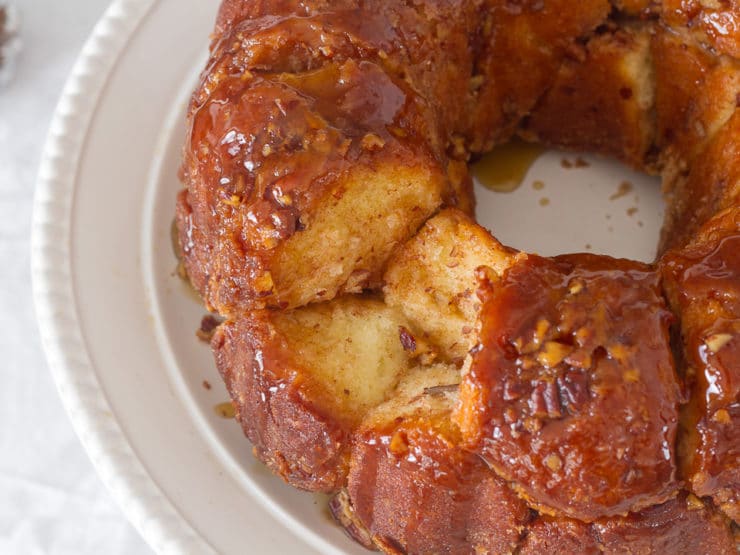
In 1942 in the midst of World War II rationing -– shortly before ZaSu Pitts’ savory buttery monkey bread made its initial appearance and many years before any record of a sugar topping for monkey bread — General Mills promoted “Hungarian Coffee Cake” in its “Betty Crocker Kitchen Clinic.” For what many Americans now call monkey bread is actually a venerable Hungarian treat, arany galuska (“golden dumplings”), consisting of balls of yeast dough dipped in melted butter, then in sugar frequently mixed with cinnamon and/or chopped nuts. I found General Mill’s adaptation in the Thursday October 15, 1942 edition of the Greene County Examiner-Recorder, Catskill, N.Y. (page 6) explaining “prepared for your newspaper by Betty Crocker home service department”:
“Coffee cakes are suggested as one way to meet the dessert problem when we find ourselves scraping the bottom of the sugar bowl and our next sugar ration still several days away…. Now for a cake that will bring welcome gasps of surprise and approval from the family and guests. It’s called Hungarian Coffee Cake – which doesn’t convey any notion of its novelty and delicious-ness.”
Betty Crocker had a knack for turning unknown dishes into American standards. A reprint of “Hungarian Coffee Cake” was included in the 1949 edition of the Betty Crocker Cookbook.
As “Hungarian coffee cake” and “monkey bread” spread into mainstream America –- both made from dough pieces bathed in butter and baked in a ring pan — they were confused with each other, with monkey bread emerging as the most common term for the sugar-coated treat. Even General Mills promotions by the 1990s began entitling it “Monkey Bread.”
Without the sugar coating, monkey bread is customarily a centerpiece and serves as a rich way to start the meal in place of rolls. With the sugary veneer, it is a delightful and delicious dessert or snack. Some cooks prepare the cake the night before, then bake it the following morning to enjoy warm from the oven. A newer innovation drizzles it with a cream cheese glaze. Gorilla bread is an early 21st century innovation inserting a little cinnamon-sugar coated cube of cream cheese in the center of each dough ball.
Kids and kids-at-heart love this fun-to-eat treat. I like to present the cinnamon variation after a fancy dinner party as a second dessert and accompaniment to coffee and tea. Any leftovers, I divide among the guests for their following morning breakfast. It is definitely a cake worth making a monkey of yourself.
Recommended Products:
We are a participant in the Amazon Services LLC Associates Program, an affiliate advertising program designed to provide a means for us to earn fees by linking to Amazon.com and affiliated sites. As an Amazon Associate I earn from qualifying purchases.
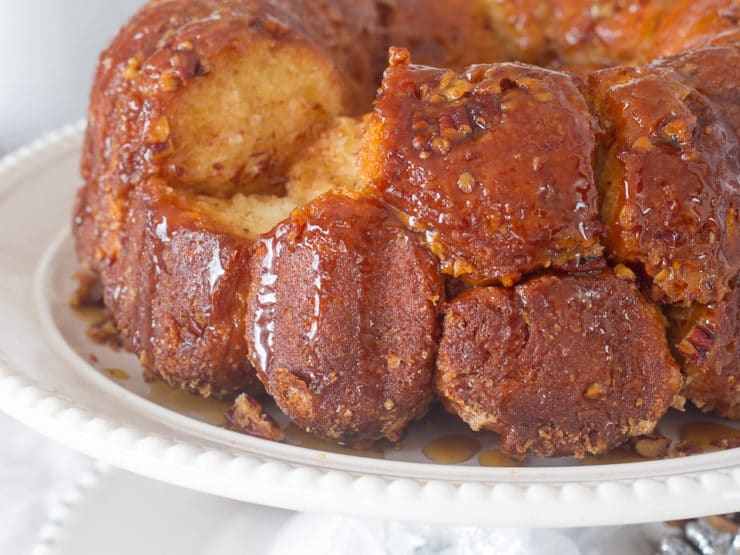
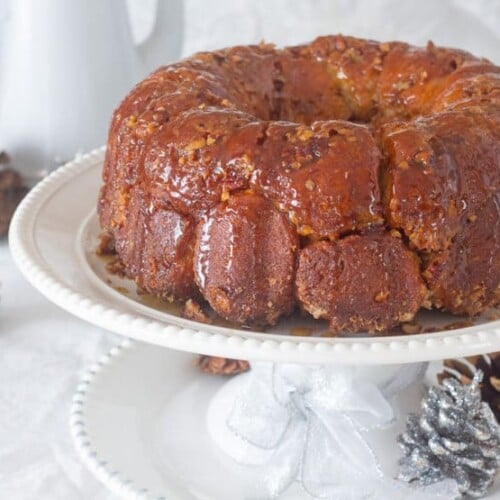
Monkey Bread (Hungarian Coffee Cake)
Ingredients
- 1 package active dry yeast (¼-ounce/7 grams/2¼ teaspoons); or 1 cake fresh yeast (0.6-ounce/18 grams); or 2 teaspoons instant yeast
- 1/4 cup warm water (105 to 115°F for dry yeast; 80 to 85°F for fresh yeast)
- 3/4 cup warm milk or buttermilk, or 6 tablespoons milk and 6 tablespoons sour cream (5.125 ounces/180 grams)
- 1/3 cup granulated sugar (2.25 ounces/65 grams)
- 1/2 cup unsalted butter, softened (1 stick/4 ounces/115 grams)
- 1 large egg (1.75 ounces/50 grams)
- 1 large egg yolk
- 1 teaspoon table salt
- 3 3/4 cups unbleached all-purpose flour or bread flour (18.5 ounces/525 grams)
- 1 cup dried currants or raisins (optional) (5 ounces/145 grams)
Topping Ingredients
- 1/2 cup unsalted butter, melted (1 stick/4 ounces/115 grams)
- 1 cup granulated sugar or packed light brown sugar (7 ounces/200 grams)
- 2 teaspoons ground cinnamon
- 1/2-1 cup finely chopped lightly toasted pecans or walnuts (optional)
NOTES
Instructions
- To make the dough: In a small bowl or measuring cup, dissolve the yeast (except instant yeast) in ¼ cup water. Stir in 1 teaspoon sugar and let stand until foamy, 5 to 10 minutes.

- In a large bowl, combine the yeast mixture, milk, the remaining sugar, butter, egg, egg yolk, and salt.

- Blend in 1½ cups flour. If using instant yeast, do not dissolve, but add here. Gradually add enough of the remaining flour to make a soft dough.

- On a lightly floured surface or in a mixer with a dough hook, knead the dough until smooth and springy, about 5 minutes. If using, knead in the currants. Place in an oiled bowl and turn to coat. Cover with a kitchen towel or loosely with plastic wrap and let rise in a warm, draft-free place until doubled in bulk, about 2 hours, or in the refrigerator overnight.Grease a 10-inch (12-cup) tube or Bundt pan or two 9-inch ring molds. (If the pan has a removable bottom, line the outside with foil to prevent the butter from dripping.) In place of a tube pan, place a custard cup or foil lined 1½-inch tube in the center of a round, deep baking pan or casserole.

- Punch down the dough, knead briefly, and shape into 1-inch balls. Combine the sugar, cinnamon, and, if using, nuts. Dip the balls into the melted butter, then roll in the sugar mixture to lightly coat.

- Arrange the balls in the prepared pan no more than halfway full. Cover with a towel or plastic wrap spritzed with cooking spray and let rise at room temperature until nearly doubled in bulk, about 45 minutes.Position a rack in the lower third of the oven. Preheat the oven to 375°F (350°F for a convection oven).

- Bake until golden brown or the center of the dough registers about 180°F on an instant-read thermometer, 40 to 50 minutes. Place the pan on a wire rack and let cool for 5 minutes, then loosen the sides of the cake and invert onto a serving platter. Serve warm or at room temperature. Cover with plastic wrap and store at room temperature for up to 2 days. Pull away pieces for your own barrel of fun.

Nutrition

tried this recipe?
Let us know in the comments!
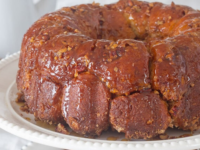
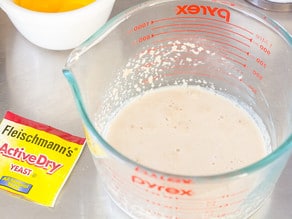
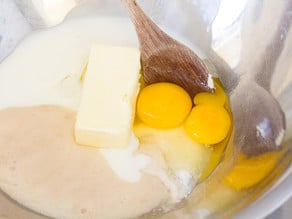

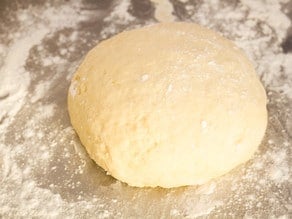
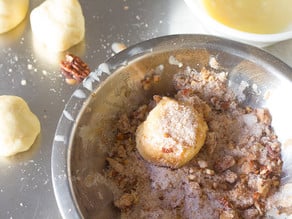
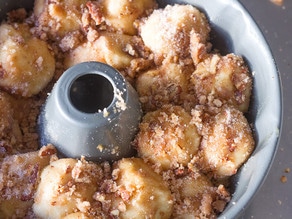
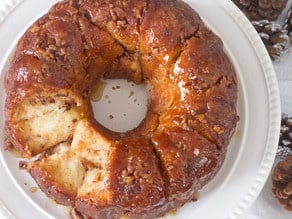


My father was s Hungarian pastrycook trained at the Gerbeaud in Budapest. He made arany galuska. No cinnamon, just coarsely ground walnuts, sugar and melted butter, it was simply the best and was served warm with a hot wine sauce called bor sodo…similar to a zabaglione
Yummy!!! We wish you great new year full of love happiness success xxxx
So very good! It’s been awhile since I made this!
Thank you for sharing this Tory. Years ago they made Monkey Bread at Beth Israel here in Houston, Tx. I recall that it was made with a certain Pillsbury Biscuit that is not longer on the market …also a Half and Half cream was poured over it before baking…I was wondering if anyone still had that recipe. I would love to have it. Teri Schwartz Goldfield
Been making Monkey Bread for 30 years or more, but I cheat I use Pillsbury canned biscuits rolled up or Grands cut in half and rolled up. Sprinkle some nuts in the bottom of bundt pan with some melted butter and 1/4 cup brown sugar. Dip dough in melted butter, roll in cinnamon sugar mix and place in pan, pour left over butter and sugar mix over dough and bake 350 for about 20 minutes or so. Cover pan with plate and carefully turn onto plate. Real good and the kids loved it they called them Monkey Balls.
A fun food but I’ll stick tov using canned biscuits or biscuit mix. I will have to try a savory version sometime
kind of a bubkes
love monkey bread,first had it at a bed and breakfast
I make mine the easy way with frozen dough balls
This is a much nicer version than what I was told while in culinary school.
Interesting history.
Anyone who can put the monkeu btead controversy to rest is a force to be reckoned with. You are sooo cool !
Hope you had a good holuday and a happy new year.
Mmmmmm monkey bread I always are mine with pecans and craisins
I have made Monkey Bread & it is so easy & delicious.
i love monkey bread
My mom (z”l) always made
a savory monkey bread with melted butter, garlic salt and either poppy seeds or sesame seeds. She served it at dinner. I was told it was called monkey bread because monkeys pick and pull at things like this bread. I make both her savory version and the sweet with cinnamon and brown sugar and pecans version.
Thought it was “monkey” bread bc you pick at it like monkeys pick and clean each other…?? That was the story we grew up with.
Would it be possible to adjust this recipe using RapidRise yeast? I’d assume that would just involve mixing the yeast with the dry ingredients rather than with the liquids, and possibly a shorter rise time.
I have had the sugary sort many times, but never the original. Have to try it sometime.
I will have to read, always wondered about that, but it sure is a yummy treat.